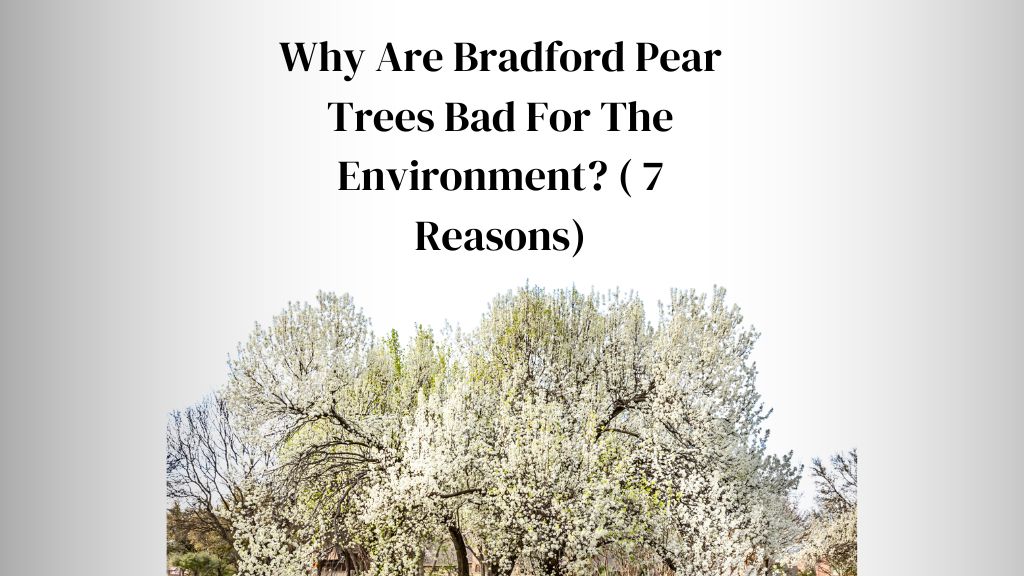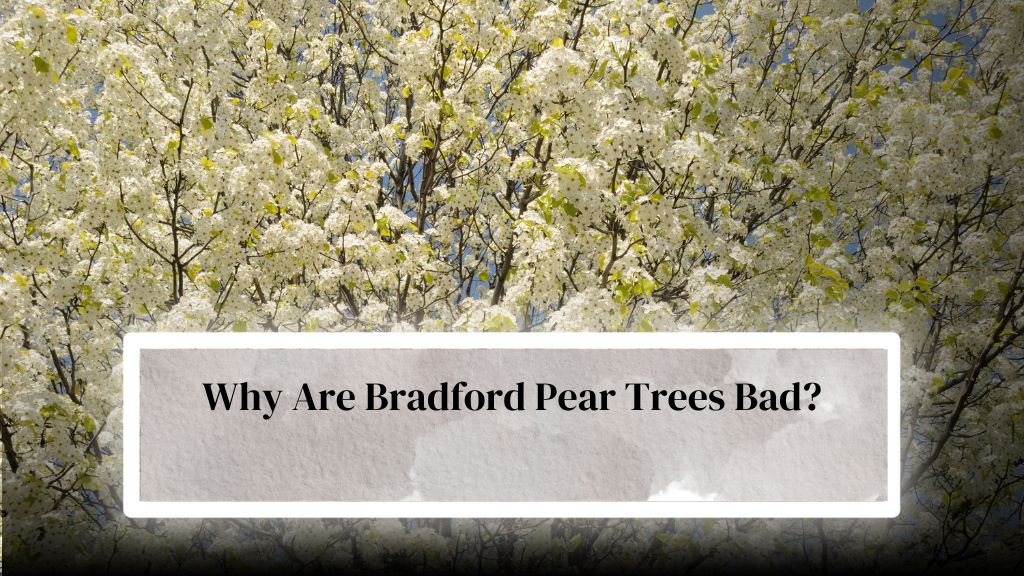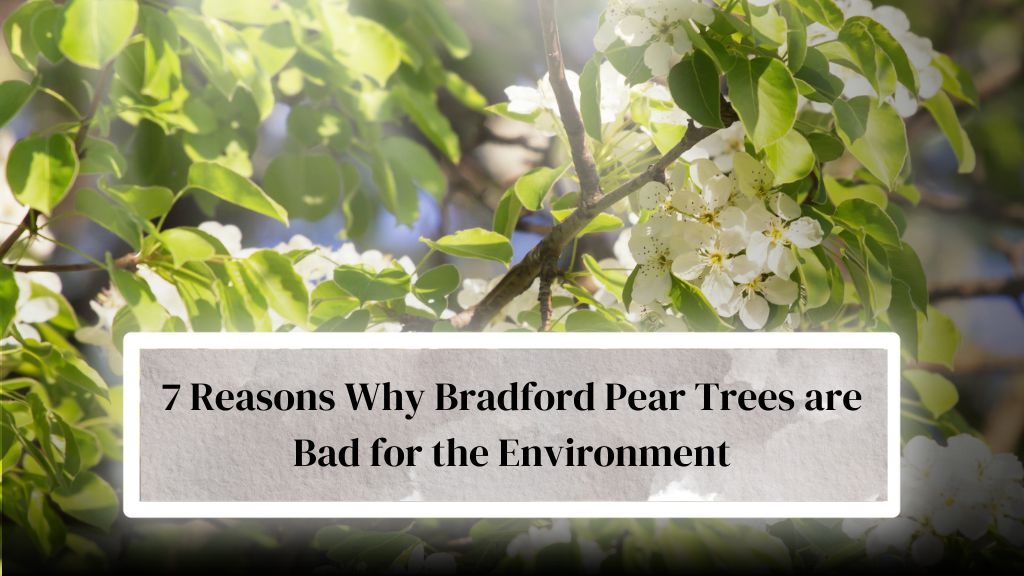
If you’re wondering ‘why are Bradford pear trees bad for the environment?’, consider reading this article thoroughly. Even though Bradford Pear trees are popular ornamental trees widely planted for their aesthetic appeal & landscape enhancement, many people consider them a poor specimen.
However, several negative aspects of Bradford Pear trees make them bad for the environment. In this article, I will tell you why Bradford Pear trees are bad, the pros and cons of Bradford Pear trees, and their impact on the environment. Let’s begin with the pros & cons first.
Pros & Cons of Bradford Pear Trees
| Pros | Cons |
| Aesthetic appeal | Weak wood structure |
| Seasonal changes | Susceptibility to diseases and pests |
| Landscape enhancement | A short lifespan (15-25 years) |
| Tolerant to pollution and drought | Invasive species |
| Easy to propagate | Incompatibility with native ecosystems |
Why Are Bradford Pear Trees Bad?

Interestingly, Bradford Pear trees are considered bad for their weak wood structure that is prone to breaking in high winds or heavy snow, which can cause property damage or personal injury. To know more about this, consider reading “Is Bradford Pear a Hardwood?“.
Another problem with Bradford Pear trees is their susceptibility to diseases and pests. Fire blight is a common bacterial disease affecting Bradford pear trees’ leaves, branches, and flowers.
Plus, other pests can attack & harbor these trees, including aphids, spider mites, & scale insects, making it a poor choice. Plus, it’s not a long-lasting tree to have. Bradford Pear trees come with a short lifespan of 15-25 years, which means you will need to replace them frequently.
Are Bradford Pear Trees Bad for Allergies?
I must warn you that pollen production is a significant concern regarding allergies, and Bradford Pear trees are no exception. As you may already know, trees produce a lot of pollen, which can cause allergic reactions in some people.
However, I would like to inform you that Bradford is not the worst offender in terms of pollen production. I have learned from a study published in the American Academy of Allergy, Asthma & Immunology that Bradford Pear trees produce moderate amounts of pollen compared to other tree species. For instance, oak trees produce significantly more pollen than Bradford Pear trees.
Nonetheless, if you are susceptible to allergies, I’ll advise you to consider the pollen production of any tree species you plan to plant in your landscape.
Furthermore, I would like to tell you that Bradford pear tree structural weaknesses and susceptibility to pests and diseases can also cause allergies in some people.
The pollen from these trees can trigger allergic reactions like sneezing, runny nose, and itchy eyes in people with an oversensitive immune system. Therefore, it’s always wise to do thorough research before selecting a tree species for your garden or landscape.
Are Bradford Pear Trees Bad for the Environment?
Yes, the Bradford pear tree is considered a bad species for the environment due to its invasiveness & impact on biodiversity. Since they’re not native to North America & have no natural predators, thus, this specimen can quickly take over an ecosystem and outcompete native species.
This can lead to an unwanted & unnecessary loss of biodiversity & ecosystem services. Bradford Pear trees are considered invasive in many parts of North America. Many states have also banned these species because they spread quickly and can take over natural areas, displacing native plants & animals.
If you’re wondering “is Bradford Pear Tree Bans in Ohio” or “is Bradford Pear Tree Banned in SC”, you’re not alone. To know in-depth, consider reading “What states have banned Bradford pear trees“.
Hence, you should only plant a tree if they are well adapted to the ecosystem of North America. Therefore, Bradford Pear trees will add little to no value to the native wildlife & plants. This specimen is also resident to test and doesn’t provide food or shelter for native Birds, mammals, or insects.
7 Reasons Why Bradford Pear Trees are Bad for the Environment

Weak Wood Structure
Because of their fragile wood structure, Bradford Pear trees are vulnerable to wind and storm damage. Since this tree’s Growth rate is relatively fast, it makes the wood less dense and more brittle.
Trees like Osage orange produce strong & valuable wood because they’re a slow grower who takes time. Bradford Pear trees are more likely to snap in extreme weather events, damaging property or causing injuries.
Susceptibility to Storm Damage
As you know, Bradford Pear trees are also susceptible to storm damage due to their shallow root system. The shallow roots can make your trees more likely to be uprooted during storms, which can cause significant damage.
Inability to Support Wildlife
As I told you, Bradford Pear trees are unsuitable for supporting wildlife, and they can disrupt the local ecosystem & negatively impact native wildlife populations. Unlike native tree species, Bradford Pears do not provide adequate food or shelter for local wildlife.
Invasive Roots
You should be aware that Bradford Pear trees have invasive roots that can cause damage to sidewalks, driveways, & other structures. If you have many plants in your area, you should avoid planting this species because their roots can easily interfere and outcompete with other plants, causing them to die.
Creates Monocultures
Yes, Bradford Pear trees can create monocultures, where only one species of tree grows in an area. This can be extremely problematic because it reduces the ecosystem’s biodiversity and makes it more vulnerable to pests & diseases.
Outcompetes Native Plants
As I told you in the previous section, Bradford Pear trees can outcompete native plants in your area, which can negatively impact the local ecosystem. You should know that native plants are better adapted to the local climate & soil conditions, and their removal can have unintended consequences.
Plus, it can be costly for you to remove such a tree from your property if required. Here, you can determine the cost to remove a Bradford pear tree from a specific property, depending upon different factors.
Produces Offensive Odour
Finally, Bradford Pear trees are also known to produce an offensive odor that can be unpleasant for some people. The odor is similar to rotting fish, which gets more intense in the spring when Bradford pears bloom. To know more about this smell, check this article: Why Do Bradford Pear Trees Smell Bad?
Alternatives to Bradford Pear Trees
It is best if you first avoid choosing a planting tree. Many great alternatives can make a great addition to your landscape or garden. If you want similar features, consider going with the dogwood trees.
I have covered this species in depth on my website. Other than this, there are a few other alternative tree species that are native to North America you can grow.
It would be best if you considered going with native species because they are well adapted to local climate & soil conditions but also provide food & shelter for local wildlife while not being invasive. Some of the alternative native tree species that you can plant in your landscape are:
- Dogwood trees
- Redbud trees
- Serviceberry trees
- Crabapple trees
- Japanese maple trees
Benefits of Planting Native Trees
You should know that there are many benefits of planting native species, like they are well adapted to the local climate condition. Therefore, you don’t have to worry about extreme temperature fluctuations in your area if you choose the native species.
It is also important to choose the native species for the type of soil found in your location. The native species are well adapted to soil conditions, requiring less water, fertilizers, and pesticides than nonnative species.
Having a native species will also provide many opportunities for wildlife for food and shelter, which will ultimately help in maintaining a healthy ecosystem.
Few native species can become invasive under a few circumstances; they won’t disturb or disrupt the local ecosystem like the nonnative species. If you are looking to support the biodiversity in your area and create a healthy environment for local wildlife through your landscape, you should consider planting native species.
Conclusion
This article has helped you learn why Bradford pear trees are bad for the environment. If you have any questions regarding ‘Are Bradford pear trees bad for the environment or ‘Why are Bradford pear trees bad, let me know in the comment section.
If this species is not native to your particular area, get the one that is. It’s best to grow native species as it not only helps maintain a healthy ecosystem but also saves you a lot of effort and money that you might spend on extra fertilizers & care to provide species.
If you find this article helpful, then consider sharing this. I tried to give you all the information you needed on the question, ‘Why are Bradford pear trees bad.’ Check our other helpful guide on Bradford pear tree care & management shared on this website. See you in the next post; till then, take care and goodbye.
